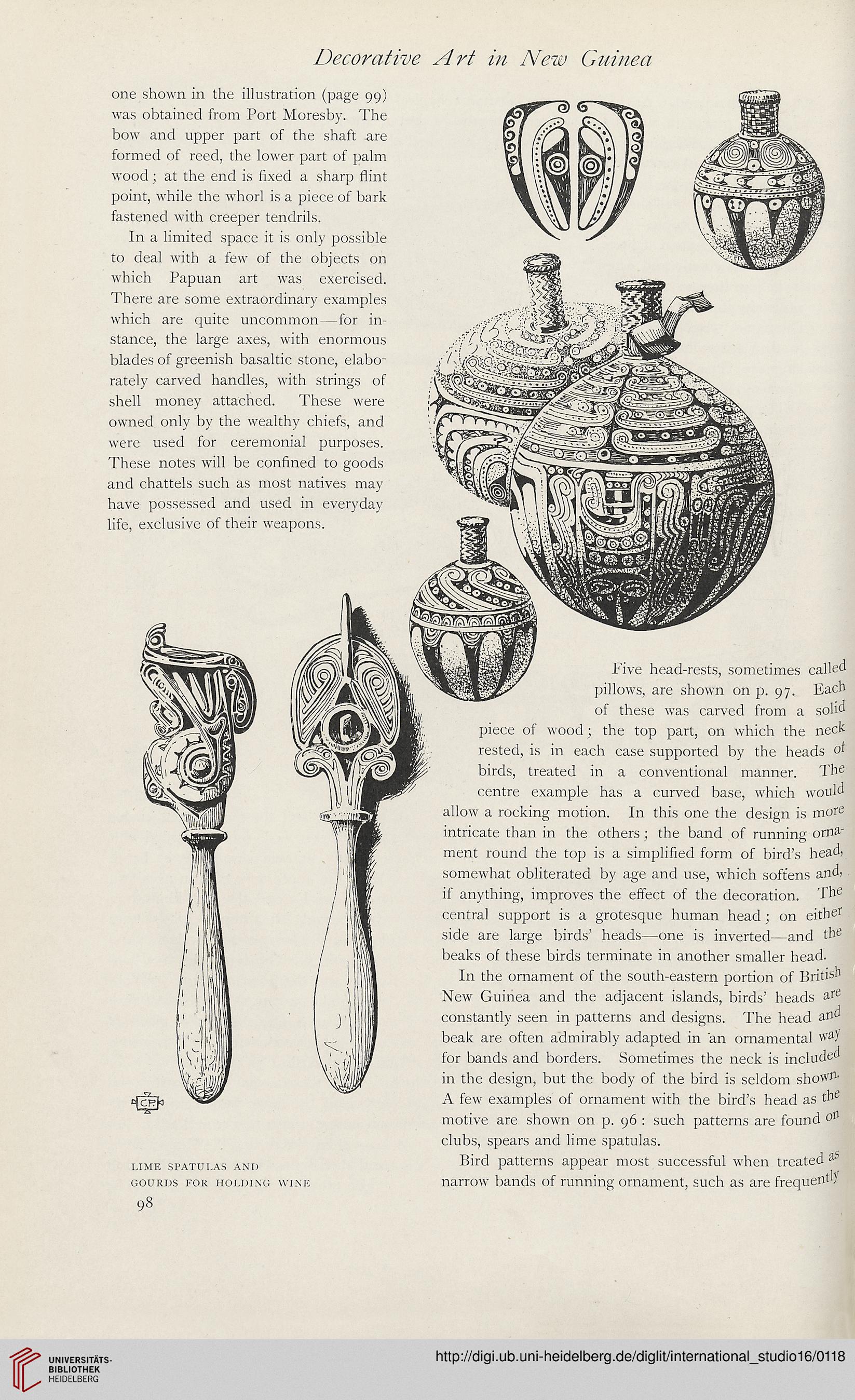Decorative Art in New Guinea
one shown in the illustration (page 99)
was obtained from Port Moresby. The
bow and upper part of the shaft are
formed of reed, the lower part of palm
wood; at the end is fixed a sharp flint
point, while the whorl is a piece of bark
fastened with creeper tendrils.
In a limited space it is only possible
to deal with a few of the objects on
which Papuan art was exercised.
There are some extraordinary examples
which are quite uncommon—for in-
stance, the large axes, with enormous
blades of greenish basaltic stone, elabo-
rately carved handles, with strings of
shell money attached. These were
owned only by the wealthy chiefs, and
were used for ceremonial purposes.
These notes will be confined to goods
and chattels such as most natives may
have possessed and used in everyday
life, exclusive of their weapons.
LIME SPATULAS AND
GOURDS FOR HOLDING WINE
Five head-rests, sometimes called
pillows, are shown on p. 97. Each
of these was carved from a solid
piece of wood; the top part, on which the neck
rested, is in each case supported by the heads of
birds, treated in a conventional manner. The
centre example has a curved base, which would
allow a rocking motion. In this one the design is more
intricate than in the others; the band of running orna-
ment round the top is a simplified form of bird’s head,
somewhat obliterated by age and use, which softens and,
if anything, improves the effect of the decoration. The
central support is a grotesque human head ; on either
side are large birds’ heads—one is inverted—and the
beaks of these birds terminate in another smaller head.
In the ornament of the south-eastern portion of British
New Guinea and the adjacent islands, birds’ heads are
constantly seen in patterns and designs. The head and
beak are often admirably adapted in an ornamental wa)
for bands and borders. Sometimes the neck is in eluded
in the design, but the body of the bird is seldom shown
A few examples of ornament with the bird’s head as the
motive are shown on p. 96 : such patterns are found 011
clubs, spears and lime spatulas.
Bird patterns appear most successful when treated a
narrow bands of running ornament, such as are frequent')'
98
one shown in the illustration (page 99)
was obtained from Port Moresby. The
bow and upper part of the shaft are
formed of reed, the lower part of palm
wood; at the end is fixed a sharp flint
point, while the whorl is a piece of bark
fastened with creeper tendrils.
In a limited space it is only possible
to deal with a few of the objects on
which Papuan art was exercised.
There are some extraordinary examples
which are quite uncommon—for in-
stance, the large axes, with enormous
blades of greenish basaltic stone, elabo-
rately carved handles, with strings of
shell money attached. These were
owned only by the wealthy chiefs, and
were used for ceremonial purposes.
These notes will be confined to goods
and chattels such as most natives may
have possessed and used in everyday
life, exclusive of their weapons.
LIME SPATULAS AND
GOURDS FOR HOLDING WINE
Five head-rests, sometimes called
pillows, are shown on p. 97. Each
of these was carved from a solid
piece of wood; the top part, on which the neck
rested, is in each case supported by the heads of
birds, treated in a conventional manner. The
centre example has a curved base, which would
allow a rocking motion. In this one the design is more
intricate than in the others; the band of running orna-
ment round the top is a simplified form of bird’s head,
somewhat obliterated by age and use, which softens and,
if anything, improves the effect of the decoration. The
central support is a grotesque human head ; on either
side are large birds’ heads—one is inverted—and the
beaks of these birds terminate in another smaller head.
In the ornament of the south-eastern portion of British
New Guinea and the adjacent islands, birds’ heads are
constantly seen in patterns and designs. The head and
beak are often admirably adapted in an ornamental wa)
for bands and borders. Sometimes the neck is in eluded
in the design, but the body of the bird is seldom shown
A few examples of ornament with the bird’s head as the
motive are shown on p. 96 : such patterns are found 011
clubs, spears and lime spatulas.
Bird patterns appear most successful when treated a
narrow bands of running ornament, such as are frequent')'
98




